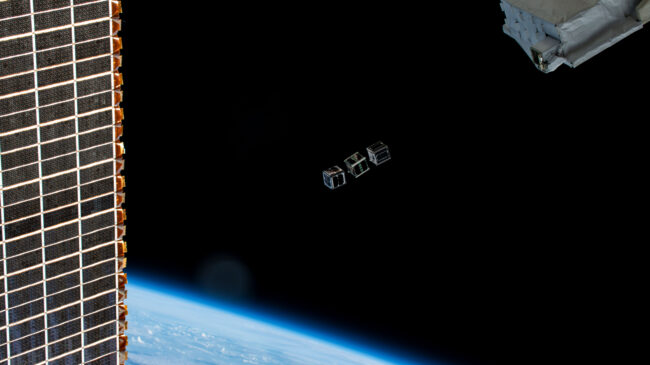On June 28, 2022, NASA launched a 55-pound Cube Satellite called CAPSTONE, or Cislunar Autonomous Position System Technology Operations and Navigation Experiment, in an attempt to establish a near-rectilinear halo orbit around the moon. On Nov. 16, CAPSTONE reached its target. This tiny satellite is groundbreaking in several ways beyond its scientific achievements, most notably in the comparatively low costs it took to carry out this project.
CAPSTONE was not designed, built, or even operated by NASA. In fact, it’s not owned by NASA. It is owned by its developer, Colorado-based Advanced Space. The CAPSTONE launch and development ended up being far cheaper than other lunar launches thanks to the terms of NASA and Advanced Space’s contract.
Historically, NASA has contracted work via cost-plus contracts wherein NASA pays for all the expenses of a project plus a fixed fee to serve as the profit for the contracted company. This approach often leads to cost overruns, as companies are able to spend as much as they want on a project. The CAPSTONE project, however, had a fixed price, ensuring more efficient project design and delivery within set budgetary constraints. This approach mirrors existing contracts between NASA and SpaceX, which help enable the transportation of astronauts to the International Space Station.
Giving Advanced Space ownership and control over CAPSTONE also helped the company cut through the red tape NASA would have otherwise faced. While traditional NASA projects involve a complex government approval process, CAPSTONE only required approval of the initial fixed fee.
This arrangement allowed Advanced Space the breathing room necessary to bring in partners throughout the process. Terran Orbital Corporation helped with designing and producing the hardware that flew on CAPSTONE as well as its assembly. Stellar Exploration provided the propulsion system design, testing, and manufacturing. Rocket Lab gave CAPSTONE a rideshare of sorts; they flew the CubeSat on an Electron Rocket flight to put it on its path toward near-rectilinear halo orbit.
Due to the nature of the contract and Advanced Space’s ownership, the company was also able to innovate freely on the CAPSTONE satellite as long as it remained within budget. And if costs went over, it would be the company’s responsibility, not NASA’s—or taxpayers—to pay for it.
This type of private sector control can also lead to innovations. For example, when Advanced Space decided to add an atomic clock to the CubeSat, without needing to go through a lengthy NASA approval process, the company gained the ability to compare the time on the atomic clock with what was broadcast from Earth so that Advanced Space could more easily pinpoint the satellite’s location in space.
CAPSTONE stands out financially in two ways. First, compared to other lunar orbit launches, CAPSTONE turned out to be far cheaper. CAPSTONE’s development cost $13.7 million, and the launch of the satellite cost $9.95 million, bringing the project’s overall costs to roughly $23.65 million. In comparison, NASA’s 2018 Transiting Exoplanet Survey Satellite launch, which sought to also to orbit the moon, had a far bigger overall price tag of $87 million to launch on a SpaceX Falcon 9. Beresheet, an effort to land on the moon spearheaded by SpaceIL—an Israeli nonprofit—cost nearly $100 million and failed.
Second, CAPSTONE’s fixed-price contract was less expensive than its cost-plus alternatives. While CAPSTONE reached the finish line for $23.65 million, the Space Launch System (SLS), NASA’s next moon rocket being developed by Boeing, cost about $20 billion to develop, and NASA far underestimated launch costs which have increased from $500 million to $4.1 billion per launch. The Orion spacecraft, also negotiated under a cost-plus contract, has cost $12 billion.
By contracting out the design, development, and operation of CAPSTONE, NASA and Advanced Space achieved an incredibly cost-efficient project. Bill Nelson, NASA’s administrator, gave reassuring signs that this form of NASA contract could be increasingly used by NASA in the future: “It’s another way for NASA to find out what it needs to find out and get the costs down.” In the past, Nelson has also referred to cost-plus contracts as a “plague” on NASA.
We can continue to expand the final frontier without breaking the bank so long as NASA continues contracting with fixed prices rather than rewarding cost overruns. By taking some of the red tape out of space exploration and development, NASA has helped open a promising new frontier for more than just the ongoing Artemis Project but for all of their projects going forward.

